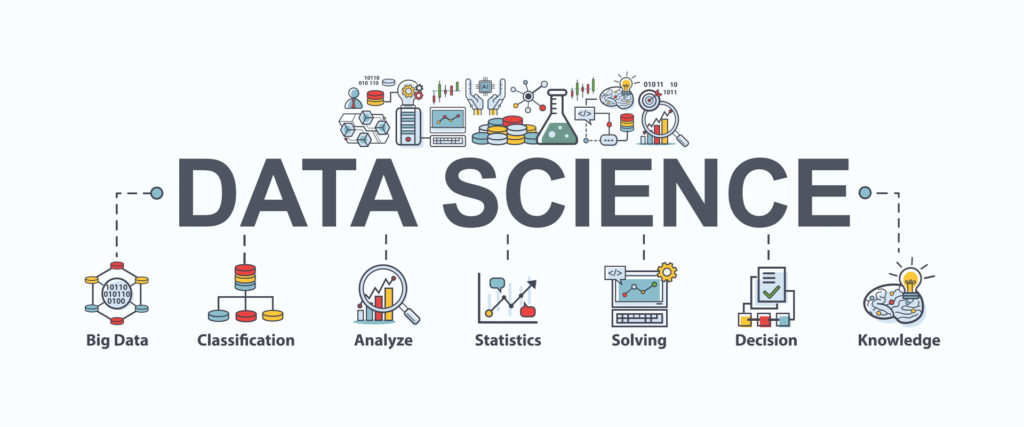What is Data Science (in the automotive sector)?
Data. We need data. Lots of data. We want data on what cars are on the road, in detail if possible. Who drives these cars, and what services might the user like? How old are these? And that’s still the easy part. We also want data on traffic impacts, preferably simulated virtually, to conduct tests for autonomous driving. Where do we even get this data from, after all we need millions and millions of data to build reliable models. And when we have all this data – what do we do with it? How do we evaluate data, how do we structure it, how do we train models with it? What does Artificial Intelligence have to do with it, what NLP, what Big Data?

Let’s start with the definition of general Data Science as provided by Wikipedia: “Data Science is an interdisciplinary field of science that provides scientifically sound methods, processes, algorithms, and systems for extracting insights, patterns, and inferences from both structured and unstructured data.” That sounds good, we can work with that: So data science is not just one thing – rather, it is a wide variety of research fields combined. Mathematics is the basis everywhere; in Data Science we do a lot of calculations, or even better, we let them be done. Information technology, signal processing (especially important in the automotive sector), machine learning, statistical learning, programming, pattern recognition (also of exposed importance), prognostics, data warehousing. That’s a lot of stuff coming together, and each branch is important and needs to interact with each other to be efficient.
Data Science in Automotive – What are the special features?
In the automotive sector, many of these fields converge directly – whether in the area of predictive maintenance, data collection for testing autonomous driving functions (for example, also for creating models in a game engine such as Unity), Deep Learning for further processing of text and image information, Artificial intelligence(the famous brake-assist problem: how do I prioritize when choosing which of two obstacles to avoid?), pattern search, forecasting. In the generally broad-based sector of cloud IT, Data Science is also the most important impulse technician, since cloudified data continues to be precisely that: Data. Data that wants to be collected, processed, used and sent.
All in all, it remains to be said that Data Science, like A.I., is a field of activity that is not sharply defined, but is nevertheless of elementary importance and without which digital transformation, which is used as a buzzword in many places, would not even be possible.

Since this article is intended to focus on what Data Science, albeit rarely, is called, we will keep the general part on Data Science in the automotive sector short and move directly to concrete examples developed by Cognizant Mobility to demonstrate the diversity and power of Data Science in the industry.
Data Science at Cognizant Mobility
Special mention for a practical application example should certainly be our ticket pre-analysis system “HEIDI”. In the context of E/E integration in current vehicles, tens of thousands of error tickets are generated every year, for which a preliminary analysis can significantly reduce processing costs and duration. For this purpose, the Cognizant Mobility data scientists around Dr. Daniel Isemann (Team Lead Data Science & AI) developed machine learning models that support ticket analysts. You can find details on this in the whitepaper on “Artificial Intelligence”, the first in a whole series. To make sure you don’t miss any more whitepapers, news, information and trends in the industry, we recommend subscribing to our free but info-packed newsletter – don’t worry, it only comes out once a month, so we’re guaranteed not to spam you.
Another interesting approach to dealing with a large amount of data is our very practical example of “Identity Storage”. With this, vehicle, contract and dealer data are stored centrally and made available. For this BMW system, Cognizant Mobility with Vera Yordanova’s team provides the corresponding backend in a 24/7 running live system.
Beyond the automotive sector, Cognizant Mobility solutions are even finding their way into the medical field. Here, the task was to detect certain conditions – a discipline that has always existed in the automotive industry: Drive, or don’t drive, to take the simplest example. Using the BOSS (Bag-Of-SFA-Symbols) method, it was possible to translate a signal time series into a language processing problem and, using the “One-Nearest-Neighbor”, to find an algorithm that could solve the customer’s problem.

From these projects, one can already see the enormous diversity that Data Science has to offer, and none of them involved the topic of autonomous driving. That’s about to change, as you’ll find plenty of information about this in our article on testing autonomous driving functions. What is exciting, however, is that Data Science has of course also boosted the entertainment industry: Computers and their games industry are also consequently products of Data Science. That’s where the Unity game engine comes from, which is typically used to create complex, high-resolution graphics models that are used for games – including 1:1 copies of real-world cities where players can play around with their game characters and their vehicles. The amount of data used for this, the simulated traffic, the passers-by – all this has existed for years in the entertainment industry and is now also finding practical application in testing autonomous driving functions. Using data collected in real life, for example by means of cameras cleverly placed at intersections to observe traffic for specific periods of time, highly complex traffic simulations can be created in which virtual test vehicles equipped with appropriate parameters can learn vast amounts of data before driving on actual roads. The further development of many functions of this future branch would not even be possible without Data Science and the provision and evaluation of highly complex data available in intimidating quantities.
Data Science – The Conclusion
There is no one definition of data science, unless the Wikipedia summary mentioned at the beginning of this article is enough for you. As an interdisciplinary science, it spans numerous subfields and deals with the true currency in which we all pay today, with which we all work, to which we are all exposed: Data. Data is pure knowledge, practical use and formula for the future equation. The efficient processing of this data in models, in projects, in developments and innovations that are to enable a clean, mobile, safe tomorrow is, in a sense, the backbone of the digital transformation and cannot be overemphasized in its elementary importance also in, or perhaps even especially, absolutely in the automotive industry.
The specialists of Cognizant Mobility are always ready to answer your questions or to advise you on your projects, on possible cooperations and joint developments, on the common part of the way, on the exchange of experiences – just contact us. via our contact form or also our LinkedIn account and let’s drive innovation with science that develops today what will be on the road tomorrow.













